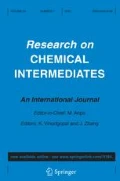Enantio-differentiating hydrogenation of methyl acetoacetate was performed over the supported nickel catalysts modified by the solution of (R,R)-tartaric acid or (S)-malic acid and NaBr. The reduction temperature of supported nickel was the most important factor determining the enantio-selectivity of catalysts. The reduction temperature changed the nickel dispersion, by which the quantity and coverage of modifier adsorption were varied. The enantio-selectivity of modifiers both (R,R)-tartaric acid and (S) -malic acid were compared at various reduction temperatures. (R,R)-tartaric acid with two hydroxyl groups in a molecule showed an optimum coverage on the nickel surface that gave the maximum ee value. The maximum ee value was 72% at the reduction temperature of 973 K. In contrast, (S)-malic acid with one hydroxyl group in a molecule showed a monotonous decrease in ee and decreasing amounts of adsorbed modifier with increasing reduction temperatures.
Similar content being viewed by others
Rights and permissions
About this article
Cite this article
Jo, D., Lee, J.S. & Lee, K.H. Enantio-differentiating hydrogenation of methyl acetoacetate over modified nickel catalysts: effects of nickel dispersion on the enantio-selectivity of catalysts. Res Chem Intermediat 30, 889–901 (2004). https://doi.org/10.1163/1568567042420730
Published:
Issue Date:
DOI: https://doi.org/10.1163/1568567042420730




